#Ensete Ventricosum
Explore tagged Tumblr posts
Text
Oldest fossilized Banana 43 million

Abstract
Fossil seeds of Ensete, a genus presently native to Asia and Africa, have been recovered from the middle Eocene of Oregon, confirming the presence of Musaceae in the North American Tertiary. The seed of Ensete oregonense sp. nov. is operculate, with a well-defined micropylar collar, a pronounced chalazal chamber, and a wide hilar cavity. A survey of seed morphology in extant Zingiberales provides characters for distinguishing Musaceae from other families of the order, furnishes criteria for distinguishing the three extant genera of Musaceae (Musa, Ensete and Musella), and facilitates critical assessment of fossil seed remains. “Musa” cardiosperma Jain from the Cretaceous/Tertiary boundary Deccan Series of India is excluded from Musaceae (although retained in Zingiberales) on the basis of fruit and seed characters, including the lack of laticifers and absence of a chalazal chamber. We reexamined the musaceous seeds from Colombia that previously were described as Tertiary fossils (Musa enseteformis Berry, 1925) and now believe that they are recent, nonfossil remains, evidently from Ensete ventricosum, which is grown in the region where the specimens were originally obtained. In addition, a reputed fossil banana fruit from the Cretaceous of Colombia was reexamined and determined to be a concretion of nonbiological origin. Ensete oregonense is significant therefore, as the first unequivocal fossil record of Ensete and of Musaceae. Although the Musaceae are currently native only to the Old World tropics, this discovery establishes that the family was present in North America about 43 million years ago.
0 notes
Text
[ahem]
Musa species are native to tropical Indomalaya and Australia; they were probably domesticated in New Guinea. They are grown in 135 countries, primarily for their fruit, and to a lesser extent to make banana paper and textiles, while some are grown as ornamental plants. The world's largest producers of bananas in 2022 were India and China, which together accounted for approximately 26% of total production. Bananas are eaten raw or cooked in recipes varying from curries to banana chips, fritters, fruit preserves, or simply baked or steamed.
Worldwide, there is no sharp distinction between dessert "bananas" and cooking "plantains": this works well enough in the Americas and Europe, but it breaks down in Southeast Asia where many more kinds of bananas are grown and eaten. The term "banana" is applied also to other members of the genus Musa, such as the scarlet banana (Musa coccinea), the pink banana (Musa velutina), and the Fe'i bananas. Members of the genus Ensete, such as the snow banana (Ensete glaucum) and the economically important false banana (Ensete ventricosum) of Africa are sometimes included. Both genera are in the banana family, Musaceae.
Banana plantations are subject to damage by parasitic nematodes and insect pests, and to fungal and bacterial diseases, one of the most serious being Panama disease which is caused by a Fusarium fungus. This and black sigatoka threaten the production of Cavendish bananas, the main kind eaten in the Western world, which is a triploid Musa acuminata. Plant breeders are seeking new varieties, but these are difficult to breed given that commercial varieties are seedless. To enable future breeding, banana germplasm is conserved in multiple gene banks around the world.
WHAT EVEN IS A BANANA?????
36 notes
·
View notes
Text




Ensete Ventricosum - Red banana Leaf
The growth since I repotted her this year has been amazing, can't wait to see her in one or two months!

#red banana#Ensete Ventricosum#ensete#banana tree#indoor jungle#cute plants#indoor plants#talking to my plants#potted plants#amo las plantas#house plants#houseplants#house jungle#houseplants club#growing plants#plants#rare plants#houseplant care#houseplant#indoor growing#indoor garden#jungle plants#plantdaddy#plantdad#plant daddy#plant gay#gayplantdad#plant papa#life#plantguy
12 notes
·
View notes
Photo

India - Karnataka - Hampi - Banana Plantagen
A banana is an edible fruit, botanically a berry, produced by several kinds of large herbaceous flowering plants in the genus Musa. (In some countries, bananas used for cooking may be called plantains.) The fruit is variable in size, color and firmness, but is usually elongated and curved, with soft flesh rich in starch covered with a rind which may be green, yellow, red, purple, or brown when ripe. The fruits grow in clusters hanging from the top of the plant. Almost all modern edible parthenocarpic (seedless) bananas come from two wild species – Musa acuminata and Musa balbisiana. The scientific names of most cultivated bananas are Musa acuminata, Musa balbisiana, and Musa × paradisiaca for the hybrid Musa acuminata × M. balbisiana, depending on their genomic constitution. The old scientific name Musa sapientum is no longer used.
Musa species are native to tropical Indomalaya and Australia, and are likely to have been first domesticated in Papua New Guinea. They are grown in at least 107 countries, primarily for their fruit, and to a lesser extent to make fiber, banana wine and banana beer and as ornamental plants.
Worldwide, there is no sharp distinction between "bananas" and "plantains". Especially in the Americas and Europe, "banana" usually refers to soft, sweet, dessert bananas, particularly those of the Cavendish group, which are the main exports from banana-growing countries. By contrast, Musa cultivars with firmer, starchier fruit are called "plantains". In other regions, such as Southeast Asia, many more kinds of banana are grown and eaten, so the simple two-fold distinction is not useful and is not made in local languages.
The term "banana" is also used as the common name for the plants which produce the fruit. This can extend to other members of the genus Musa like the scarlet banana (Musa coccinea), pink banana (Musa velutina) and the Fe'i bananas. It can also refer to members of the genus Ensete, like the snow banana (Ensete glaucum) and the economically important false banana (Ensete ventricosum). Both genera are classified under the banana family, Musaceae.
47 notes
·
View notes
Note

A banana is an elongated, edible fruit – botanically a berry[1][2] – produced by several kinds of large herbaceous flowering plants in the genus Musa.[3] In some countries, bananas used for cooking may be called "plantains", distinguishing them from dessert bananas. The fruit is variable in size, color, and firmness, but is usually elongated and curved, with soft flesh rich in starch covered with a rind, which may be green, yellow, red, purple, or brown when ripe. The fruits grow upward in clusters near the top of the plant. Almost all modern edible seedless (parthenocarp) bananas come from two wild species – Musa acuminata and Musa balbisiana. The scientific names of most cultivated bananas are Musa acuminata, Musa balbisiana, and Musa × paradisiaca for the hybrid Musa acuminata × M. balbisiana, depending on their genomic constitution. The old scientific name for this hybrid, Musa sapientum, is no longer used.
Musa species are native to tropical Indomalaya and Australia, and are likely to have been first domesticated in Papua New Guinea.[4][5] They are grown in 135 countries,[6] primarily for their fruit, and to a lesser extent to make fiber, banana wine, and banana beer, and as ornamental plants. The world's largest producers of bananas in 2017 were India and China, which together accounted for approximately 38% of total production.[7]
Worldwide, there is no sharp distinction between "bananas" and "plantains". Especially in the Americas and Europe, "banana" usually refers to soft, sweet, dessert bananas, particularly those of the Cavendish group, which are the main exports from banana-growing countries. By contrast, Musa cultivars with firmer, starchier fruit are called "plantains". In other regions, such as Southeast Asia, many more kinds of banana are grown and eaten, so the binary distinction is not as useful and is not made in local languages.
The term "banana" is also used as the common name for the plants that produce the fruit.[3] This can extend to other members of the genus Musa, such as the scarlet banana (Musa coccinea), the pink banana (Musa velutina), and the Fe'i bananas. It can also refer to members of the genus Ensete, such as the snow banana (Ensete glaucum) and the economically important false banana (Ensete ventricosum). Both genera are in the banana family, Musaceae.
The banana plant is the largest herbaceous flowering plant.[8] All the above-ground parts of a banana plant grow from a structure usually called a "corm".[9] Plants are normally tall and fairly sturdy with a treelike appearance, but what appears to be a trunk is actually a "false stem" or pseudostem. Bananas grow in a wide variety of soils, as long as the soil is at least 60 centimetres (2.0 ft) deep, has good drainage and is not compacted.[10] Banana plants are among the fastest growing of all plants, with daily surface growth rates recorded of 1.4 square metres (15 sq ft) to 1.6 square metres (17 sq ft).[11][12]
The leaves of banana plants are composed of a stalk (petiole) and a blade (lamina). The base of the petiole widens to form a sheath; the tightly packed sheaths make up the pseudostem, which is all that supports the plant. The edges of the sheath meet when it is first produced, making it tubular. As new growth occurs in the centre of the pseudostem the edges are forced apart.[13] Cultivated banana plants vary in height depending on the variety and growing conditions. Most are around 5 m (16 ft) tall, with a range from 'Dwarf Cavendish' plants at around 3 m (10 ft) to 'Gros Michel' at 7 m (23 ft) or more.[14][15] Leaves are spirally arranged and may grow 2.7 metres (8.9 ft) long and 60 cm (2.0 ft) wide.[1] They are easily torn by the wind, resulting in the familiar frond look.[16] When a banana plant is mature, the corm stops producing new leaves and begins to form a flower spike or inflorescence. A stem develops which grows up inside the pseudostem, carrying the immature inflorescence until eventually it emerges at the top.[17] Each pseudostem normally produces a single inflorescence, also known as the "banana heart". (More are sometimes produced; an exceptional plant in the Philippines produced five.[18]) After fruiting, the pseudostem dies, but offshoots will normally have developed from the base, so that the plant as a whole is perennial. In the plantation system of cultivation, only one of the offshoots will be allowed to develop in order to maintain spacing.[19] The inflorescence contains many bracts (sometimes incorrectly referred to as petals) between rows of flowers. The female flowers (which can develop into fruit) appear in rows further up the stem (closer to the leaves) from the rows of male flowers. The ovary is inferior, meaning that the tiny petals and other flower parts appear at the tip of the ovary.[20]
The banana fruits develop from the banana heart, in a large hanging cluster, made up of tiers (called "hands"), with up to 20 fruit to a tier. The hanging cluster is known as a bunch, comprising 3–20 tiers, or commercially as a "banana stem", and can weigh 30–50 kilograms (66–110 lb). Individual banana fruits (commonly known as a banana or "finger") average 125 grams (4+1⁄2 oz), of which approximately 75% is water and 25% dry matter (nutrient table, lower right).
The fruit has been described as a "leathery berry".[21] There is a protective outer layer (a peel or skin) with numerous long, thin strings (the phloem bundles), which run lengthwise between the skin and the edible inner portion. The inner part of the common yellow dessert variety can be split lengthwise into three sections that correspond to the inner portions of the three carpels by manually deforming the unopened fruit.[22] In cultivated varieties, the seeds are diminished nearly to non-existence; their remnants are tiny black specks in the interior of the fruit.[23]
The end of the fruit opposite the stem contains a small tip distinct in texture, and often darker in color. Often misunderstood to be some type of seed or excretory vein, it is actually just the remnants from whence the banana fruit was a banana flower.[24]
As with all living things on earth, potassium-containing bananas emit radioactivity at low levels occurring naturally from potassium-40 (40K or K-40),[25] which is one of several isotopes of potassium.[26][27] The banana equivalent dose of radiation was developed in 1995 as a simple teaching-tool to educate the public about the natural, small amount of K-40 radiation occurring in every human and in common foods.[28][29]
The K-40 in a banana emits about 15 becquerels or 0.1 microsieverts (units of radioactivity exposure),[30] an amount that does not add to the total body radiation dose when a banana is consumed.[25][29] By comparison, the normal radiation exposure of an average person over one day is 10 microsieverts, a commercial flight across the United States exposes a person to 40 microsieverts, and the total yearly radiation exposure from the K-40 sources in a person's body is about 390 microsieverts.[30][better source needed]
The word "banana" is thought to be of West African origin, possibly from the Wolof word banaana, and passed into English via Spanish or Portuguese.[31]
The genus Musa was created by Carl Linnaeus in 1753.[32] The name may be derived from Antonius Musa, physician to the Emperor Augustus, or Linnaeus may have adapted the Arabic word for banana, mauz.[33] According to Roger Blench, the ultimate origin of musa is in the Trans–New Guinea languages, whence they were borrowed into the Austronesian languages and across Asia, via the Dravidian languages of India, into Arabic as a Wanderwort.[34]
Musa is the type genus in the family Musaceae. The APG III system assigns Musaceae to the order Zingiberales, part of the commelinid clade of the monocotyledonous flowering plants. Some 70 species of Musa were recognized by the World Checklist of Selected Plant Families as of January 2013;[32] several produce edible fruit, while others are cultivated as ornamentals.[35]
The classification of cultivated bananas has long been a problematic issue for taxonomists. Linnaeus originally placed bananas into two species based only on their uses as food: Musa sapientum for dessert bananas and Musa paradisiaca for plantains. More species names were added, but this approach proved to be inadequate for the number of cultivars in the primary center of diversity of the genus, Southeast Asia. Many of these cultivars were given names that were later discovered to be synonyms.[36]
In a series of papers published from 1947 onwards, Ernest Cheesman showed that Linnaeus's Musa sapientum and Musa paradisiaca were cultivars and descendants of two wild seed-producing species, Musa acuminata and Musa balbisiana, both first described by Luigi Aloysius Colla.[37] Cheesman recommended the abolition of Linnaeus's species in favor of reclassifying bananas according to three morphologically distinct groups of cultivars – those primarily exhibiting the botanical characteristics of Musa balbisiana, those primarily exhibiting the botanical characteristics of Musa acuminata, and those with characteristics of both.[36] Researchers Norman Simmonds and Ken Shepherd proposed a genome-based nomenclature system in 1955. This system eliminated almost all the difficulties and inconsistencies of the earlier classification of bananas based on assigning scientific names to cultivated varieties. Despite this, the original names are still recognized by some authorities, leading to confusion.[37][38]
The accepted scientific names for most groups of cultivated bananas are Musa acuminata Colla and Musa balbisiana Colla for the ancestral species, and Musa × paradisiaca L. for the hybrid M. acuminata × M. balbisiana.[39]
Synonyms of M. × paradisiaca include
many subspecific and varietal names of M. × paradisiaca, including M. p. subsp. sapientum (L.) Kuntze
Musa × dacca Horan.
Musa × sapidisiaca K.C.Jacob, nom. superfl.
Musa × sapientum L., and many of its varietal names, including M. × sapientum var. paradisiaca (L.) Baker, nom. illeg.
Generally, modern classifications of banana cultivars follow Simmonds and Shepherd's system. Cultivars are placed in groups based on the number of chromosomes they have and which species they are derived from. Thus the Latundan banana is placed in the AAB Group, showing that it is a triploid derived from both M. acuminata (A) and M. balbisiana (B). For a list of the cultivars classified under this system, see "List of banana cultivars".
In 2012, a team of scientists announced they had achieved a draft sequence of the genome of Musa acuminata.[40]
4 notes
·
View notes
Text









Plant of the Day
Thursday 23 January 2020
Grown by many Ethiopian farmers as a staple crop Ensete ventricosum (enset, Ethiopian banana, Abyssinian banana, false banana) has over 300 varieties. This plant is principally grown as a starchy food but also as a source of fibres. The leaves can be used as plates, provide fibrous ‘wet wipes’, be processed as a food called kocho fermented from the leaf stalks (15 days fermenting above the ground and 15 days under the ground) with addition herbs and as bulla eaten as a porridge. In the U.K. ornamental varieties of this species are used to add an exotic foliage effect to plantings in the summer.
Jill Raggett
#ensete#Abyssinianbanana#falsebanana#ethiopianbanana#ethiopia#farmer#herbaceousperennial#foodcrop#crop#fibres#kocho#fermented#wetwipe#plate#plant#plants#yellowwoodadventures#ethiopianhighlands#ethiopiancoffeecompany
69 notes
·
View notes
Text
Ensete ventricosum, the tree against hunger
Have you heard about it? Sebuah tumbuhan jenis rerumputan, yang tingginya lebih dari 2 meter? Tumbuhan yang seringkali disebut sebagai pohon, padahal sebenarnya dia adalah tumbuhan herbal. Pisang, tidak asing, kan?
Di sini pisang bukan tokoh utamanya. Memang masih dalam satu famili, tapi kita akan membahas tumbuhan di genus yang berbeda. Pohon mirip pisang, sefamili dengan pisang dari genus musa, dan terkenal (meski tidak terkenal) dengan nama pisang etiopia. Namanya Ensete
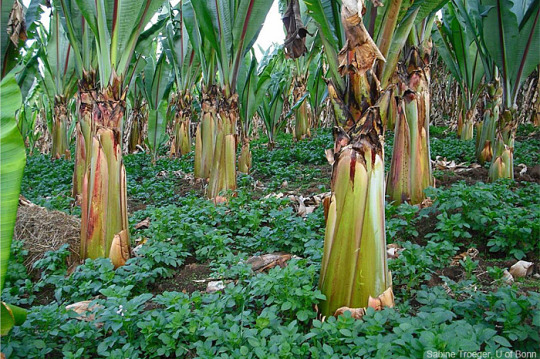
Ensete, the false banana.
Pisang banget ga sih bentuknya? Pertama kali aku tau soal Ensete, searching, liat gambarnya, reaksiku gini ; What? Ini pisang, cuk? Ekspresi ketidakpercayaan, dengan muka you’re not gonna fooling anyone here.
But, this is not your banana. This is Ensete.
Ensete tidak berbuah seperti pisang. Di dekat jantungnya, yang di pisang kita liat ada buah, di Ensete lebih mirip buah pohon pinus yang diperbesar. Isinya biji semua, yang menjijikkan kalau diliat sama orang yang pobia titik-titik weird.
Interesting, and awesome at the same point. Liat pohon ginian, bikin aku ngerasa pengetahuanku sangat-sangat cetek.
Kadang kita ngerasa kalau semakin lama, hidup semakin membosankan. Rasanya kita udah tau soal semua hal yang kita pengen tau. Hal-hal pemacu adrenalin bakal hilang lama-lama, masuk lagi ke kotak kebosanan.
But, no. Setiap hari semesta bakal kasih kejutan dari sisi yang ngga keduga. Salah satunya ya Ensete ini. Pohon yang aku yakin, kamu ngga pernah tau kalau ada. Kemungkinannya gede, tapi kalau kamu tau, ya-maap.
Let’s talk about Ensete. In points.
Ensete itu makanan pokok buat 15-20 juta orang di Etiopia. Oke, tapi bukan disitu poin pentingnya. Bagian yang edible dari ensete ini, itu akarnya.
Poin ini mindblowing banget buatku. What? Pisang dimakan akarnya? But, it’s the truth!

Kayak talas... Eh tau talas ga? Oke, taro. Dasar milenial.
Kalau masih ga paham, talas / taro, itu buah dari tumbuhan yang sering dipake buat perasa minuman / makanan. Biasanya warna ungu, saingannya matcha.
Jadi.. Kayak talas, Ensete ini yang dimakan itu bagian corm-nya. Bagian batang yang masuk ke tanah, dan gada padanan katanya di Bahasa Indonesia. Ya akar.
If we want to talk about : menyamakan padi dengan gandum, maka Ensete disamakannya dengan talas. Udah liat foto di atas? Ibu-ibu yang lagi numbuk akar Ensete biar bisa dimakan. Fyi, disitu ada 2 akar ensete, 1 lagi ditumbuk, 1-nya lagi belum ditumbuk, tapi udah digali, persis di depannya itu lho.
Keliatan lezat banget ga sih? Tumbuhan umbi-umbian segede itu? Iyalah, 40 kilogram satu pohon. Direbus rasanya kayak mukbang. Biasanya lahan seluas 250 meter persegi udah cukup buat menghidupi keluarga dengan 5-6 anggota.
Akar ensete abis ditumbuk itu mirip tepung. Starchy gitu. Starch / amilum / pati, identik sama tepung dan tumbuhan karbohidrat. Meski pati lebih identik lagi sama rumah cewekku, sih.. Eh.
Ensete ini, kalau masih fresh, bisa dimasak langsung kayak kentang. Meski lebih terkenal kalau dijadiin Kocho. Makanan khas Etiopia terbuat dari fermentasi tumbukan Ensete. Ensete ditumbuk, difermentasi, diambil, dibikin adonan, di-bake pakai peralatan tradisional, jadilah Kocho, makanan pesta Etiopia.
Slow clap.
Keren ya, Ensete. Lucu, ada tumbuhan kayak gitu.
Sekarang tugasku sudah selesai. Menulisakan garis besar super abstrak, dan ga jelas. Info-info lain agak lumayan susah dicari, jadi kutaruh aja beberapa link menarik yang aku ngga sengaja nemu.
Ini video Ensete dari awal panen sampai jadi Kocho. Komennya bahasa Etiopia semua guys.
youtube
Ini garis besar dari salah satu website organisasi paling informatif soal pisang : http://www.promusa.org/blogpost357-Enset-the-false-banana
Gitu aja sih. Bingung mau nulis apa lagi. Tapi, kalau ada rekomendasi hal-hal unik weird kayak gini, boleh dong aku dikasih tau. Butuh banyak asupan ilmu biar semakin tau kalau kita terlalu kecil buat dunia yang luas.
Terakhir (banget). Stay, humble.
4 notes
·
View notes
Text
Nobody:
Stanza: “The term "banana" is also used as the common name for the plants that produce the fruit. This can extend to other members of the genus Musa, such as the scarlet banana (Musa coccinea), the pink banana (Musa velutina), and the Fe'i bananas. It can also refer to members of the genus Ensete, such as the snow banana (Ensete glaucum) and the economically important false banana (Ensete ventricosum). Both genera are in the banana family, Musaceae.”
5 notes
·
View notes
Link
Headline writer playing fast and loose with the word “tree” but ANYWAY this is really interesting!
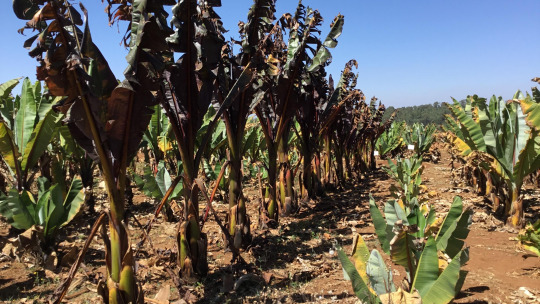
If you’ve never heard of enset, then you’re certainly not alone. Whilst enset (Ensete ventricosum) grows wild in river valleys and gorges from Ethiopia all the way down to South Africa, it has only ever been domesticated in the Ethiopian Highlands. Here it’s said that 60 plants could feed a family of five for a year.
...
Enset is a close relative of the banana, in fact, it’s commonly known as the False Banana. Whilst it grows as tall as a house, and a meter across, it’s actually a giant herb, rather than a tree. Nevertheless, it looks like a banana with big paddle-shaped leaves and produces banana like fruits, though they are unfortunately full of huge black seeds so you wouldn’t want to try and eat one. Instead it’s the pseudostem (trunk) and a large underground corm that are the edible parts.
...
Enset has a number of unusual traits that make it such a useful food security crop, and have earned it the name ‘the Tree Against Hunger’. First, you can plant it or harvest it at any time of year. Once planted, it keeps growing for up to ten or twelve years, where, eventually, it will flower and die. As long as you harvest it before this point, you can collect several hundred kilograms of starchy vegetable-like tissue that you can turn into various foods.
It’s somewhat drought tolerant, and there are hundreds of different varieties (a bit like types of potato or apple) that we think are adapted to different conditions and have different flavours or uses. Lastly, it’s clonally propagated – that means that to get new plants, you cut the top off an old plant in a special way and hundreds of new shoots will emerge which you can plant out into the fields.
...
The versatility of enset means that it can provide a long-term sustainable food supply, helping to buffer seasonal gaps in other crops, or events like crop pest or disease outbreaks.
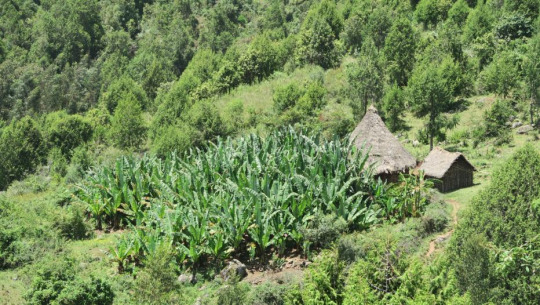
6 notes
·
View notes
Text
香蕉
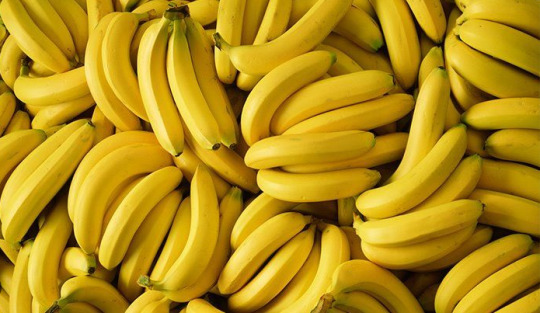
香蕉是一种细长的可食用水果——植物学上是一种浆果[1][2]——由芭蕉属的几种大型草本开花植物生产。 在一些国家,用于烹饪的香蕉可能被称为“车前草”,以区别于甜点香蕉。 果实的大小、颜色和硬度各不相同,但通常是细长和弯曲的,富含淀粉的柔软果肉覆盖着外皮,成熟时可能呈绿色、黄色、红色、紫色或棕色。 果实在植物顶部附近成簇向上生长。 几乎所有现代可食用无核(单性果皮)香蕉都来自两种野生品种——Musa acuminata 和 Musa balbisiana。 大多数栽培香蕉的学名是 Musa acuminata、Musa balbisiana 和 Musa × paradisiaca(杂交 Musa acuminata × M. balbisiana),具体取决于它们的基因组构成。 这种杂交种的旧学名 Musa sapientum 已不再使用。
芭蕉原产于热带印多马拉亚和澳大利亚,很可能首先在新几内亚被驯化。 它们在 135 个国家/地区种植,主要用于生产水果,并在较小程度上用于制造纤维、香蕉酒和香蕉啤酒,以及作为观赏植物。 2017 年世界上最大的香蕉生产国是印度和中国,合计约占总产量的 38%。
在世界范围内,“香蕉”和“车前草”之间没有明显的区别。 尤其是在美洲和欧洲,“香蕉”通常是指柔软、甜美的甜点香蕉,特别是卡文迪什集团的香蕉,它们是香蕉种植国的主要出口产品。 在美国,截至 2019 年,按磅数计算,这些香蕉是消费量最大的新鲜水果。 [8] 相比之下,果实更结实、淀粉含量更高的芭蕉品种被称为“车前草”。 在东南亚等其他地区,种植和食用的香蕉种类更多,因此二元区分没有那么有用,也没有用当地语言表示。
术语“香蕉”也用作生产这种水果的植物的通用名称。 这可以扩展到芭蕉属的其他成员,例如猩红色香蕉 (Musa coccinea)、粉红色香蕉 (Musa velutina) 和 Fe'i 香蕉。 它也可以指 Ensete 属的成员,例如雪蕉 (Ensete glaucum) 和经济上重要的假香蕉 (Ensete ventricosum)。 这两个属都属于芭蕉科香蕉科。
稳定更新
1 note
·
View note
Text


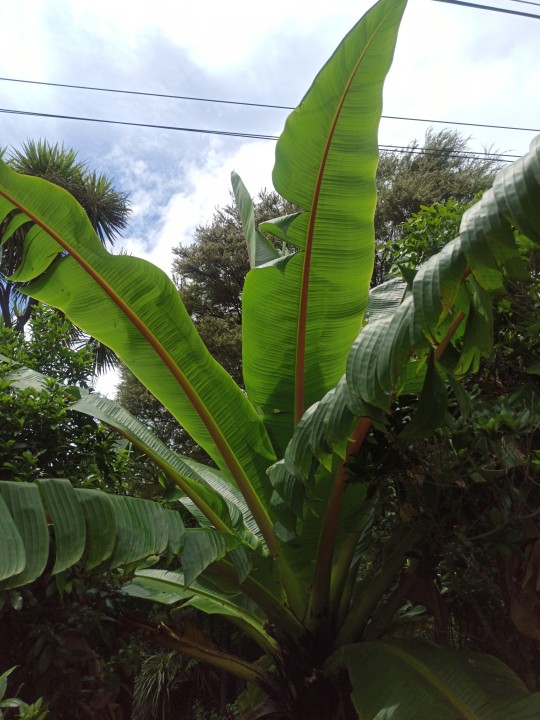
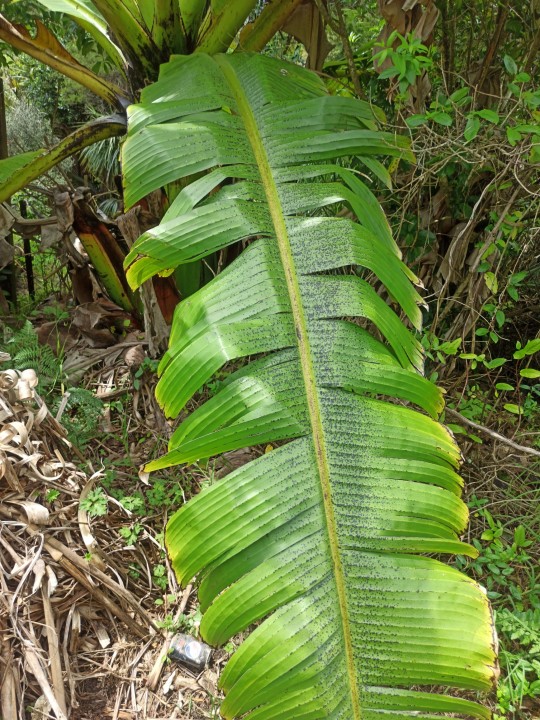
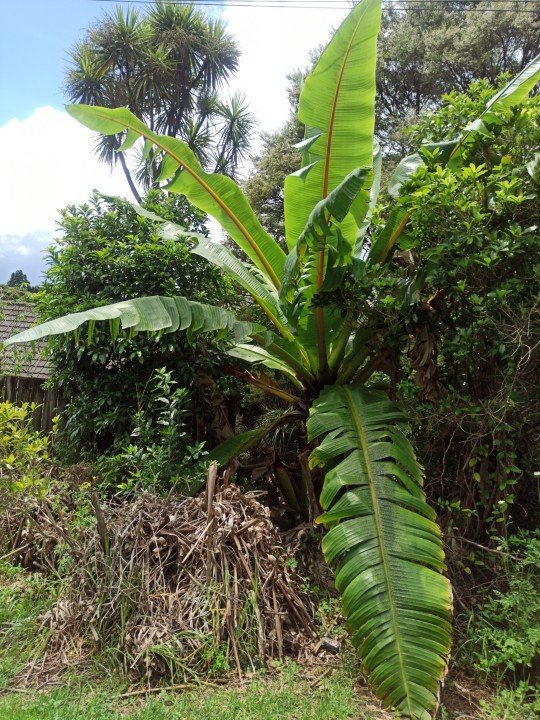
Ensete ventricosum, commonly known as the Ethiopian banana, Abyssinian banana, false banana, enset or ensete, is an herbaceous species of flowering plant in the banana family Musaceae. The name Ensete ventricosum was first published in 1948 in the Kew Bulletin, 1947, p. 101. Its synonyms include Musa arnoldiana De Wild., Musa ventricosa Welw. and Musa ensete J.F.Gmel. It is native to the eastern edge of the Great African Plateau, extending northwards from South Africa .
The abyssinian banana (Ensete ventricosum) is a vital component of Ethiopian food security. The roots, trunk, and growing point of the plant are eaten, and the leaves and harvest residue are fed to cattle. The leaves provide fiber for ropes, sacks, and baskets and when dried make an eco-friendly packaging. Seeds are used for necklaces, rattles, and rosaries.
366-392 Huia Road, Titirangi, Auckland 0604
2JXF+RGR Auckland
-36.9503860, 174.6237670
1 note
·
View note
Text

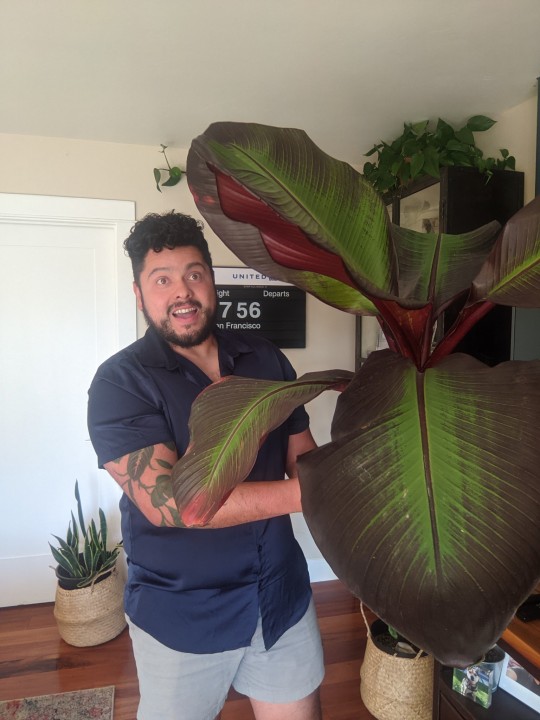

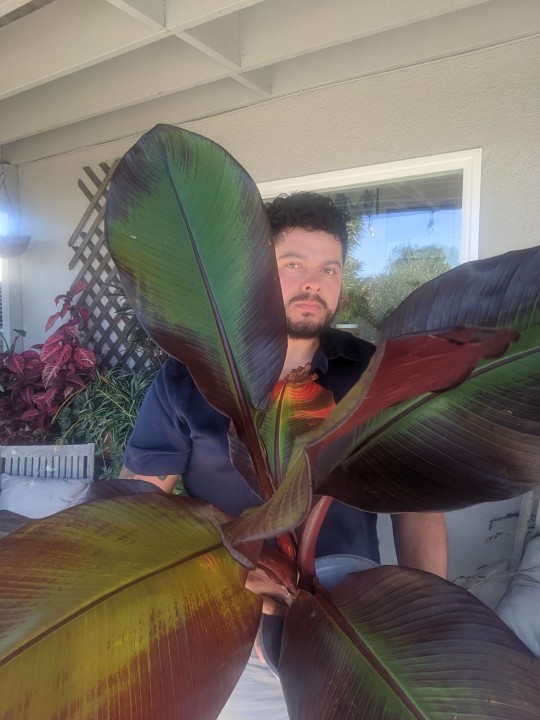

This is how I've grown my red banana leaf!
(ensete ventricosum)
Don't get me wrong, I had to make mistakes and sadly killed one before understanding their needs. I really sat and read about them and at that point I tried again and boom 💥 look at the big leaves she is developing.
* She is outside under our deck, so she gets indirect bright light (part sun/part shade) so if indoors, give them the brightest spot available.
* She has a big family living closely together, which increases their humidity (60-75%).
* She also loves to keep the soil moist. Not a fan of dry soil.
* Like alocasias, I've noticed one older leaf dies when a new leaf is unrolling, so don't freakout.
Do you have any questions? Either put them in the comments or send me a DM! I'm happy to help! 🧐

#red banana#ensete ventricosum#tropical plants#indoor jungle#cute plants#indoor plants#talking to my plants#potted plants#amo las plantas#house plants#houseplants#house jungle#houseplants club#gay planting#gayplantdad#gay#queer love#queer pride#latino plant dad#latinos with plants#gay latino#latinos#plantdaddy#plantdad#plant parents#crazy plant people#plant lovers#houseplant club#houseplants101#plant care
36 notes
·
View notes
Text
Researcher Highly Recommends Ethiopia's "Enset" Crop for Food Security, Export
Researcher Highly Recommends Ethiopia’s “Enset” Crop for Food Security, Export
“Enset” crop is undisputedly Ethiopia’s potential crop that could ascertain food security and prevent stunting, a researcher from Arba Minch University asserts. Enset crop (E. ventricosum) is found in sub-Saharan Africa and Asia, but it is domesticated and cultivated as a food crop only in Ethiopia. With its starch-rich corm and pseudo stem processed into food products, enset a staple meal for…
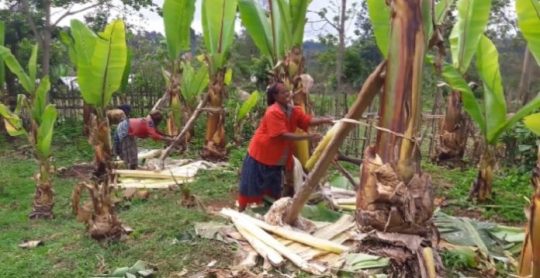
View On WordPress
0 notes
Text
How To Plan A Tropical Garden – Australian Handyman Magazine@|how to plant a tropical garden@|https://www.handyman.net.au/wp-content/uploads/2019/11/o-landscaping-design-a-tropical-garden-jul15p116-MAIN.jpg@|21
How To Plan A Tropical Garden
��� 
[external_link_head]Garden ⁄  Flowers & Plants ⁄  How To Plan A Tropical Garden
Create your very own lush landscape in the backyard whatever the climate
Words and Pictures: Cheryl Maddocks
Holidays and gardens have a lot in common, as they’re both about relaxation and pleasure.
And if you associate the tropics with wonderful vacations, you may want to keep the holiday spirit alive by creating your own permanent tropical retreat at home.
You need a rich mix of foliage textures and colours for a peaceful exotic garden mood.
Think large vibrant foliage, flamboyant flowers and eye-catching architectural statement plants.
This garden style isn’t exclusive to the tropics, as it’s also ideal for gardens that are frost-free and can provide shelter for plants from the hot afternoon sun.
Group plants with different leaf shapes together to bring out the best in both and use variegated foliage to break up green compositions.
Caring for your garden
Give your tropical plants a little TLC to keep them looking their best.
DIG copious amounts of well-rotted manure or compost into the soil. Organic matter will hold moisture in the soil to keep your large-leafed plants healthy.
FEED generously with compost or cow manure in the spring and summer.
MULCH around the plants with composted leaves, lucerne hay or pea straw to keep roots cool and retain moisture, topping up as needed.
[external_link offset=1]
WATER regularly using a hose or install a drip-watering system.

Group plants with different leaf shapes together to bring out the best in both and use variegated foliage to break up green compositions
Plant in layers
Tropical gardens are densely planted, which gives them their lush look.
They’re designed on three levels, starting with an upper canopy of taller trees and palms that create a warm microclimate and provide shade and protection for lower plants.
The middle layer is made up of shrubs and tall perennials, then at soil level, low growers give a mix of leaf textures and colours.
While the foliage colour is important, the structure, texture, shape and composition are also key considerations.
There is a huge variation in foliage shape, colour and texture, and while mainly green, it can also be colourful.
Upper canopy
You can use any trees in the upper canopy and intersperse them with palms, tall tree ferns and tall shrubs.
TOP PICKS Golden cane palm (Dypsis lutescens), kentia palm (Howea forsteriana), majestic palm (Ravenea rivularis), Alexandra palm (Archontophoenix alexandrae), giant bird of paradise (Strelitzia nicolai), Abyssinian banana (Ensete ventricosum), frangipani, lilly pilly, ivory curl tree (Buckinghamia celsissima) and brugmansia.
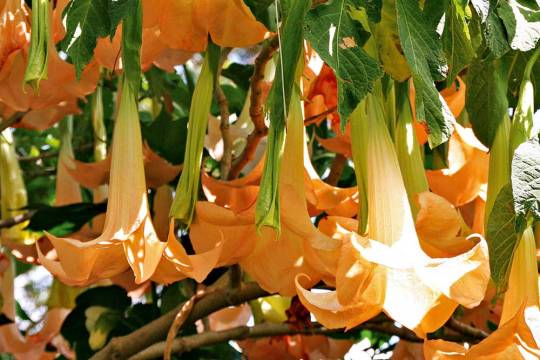
Brugmansia boasts masses of spectacular flowers in summer
Middle layer
Choose plants 1-2m high with luxuriant foliage in different shades and shapes, and featuring stunning flowers.
TOP PICKS Clustered parlour palm (Chamaedorea seifrizii), lady palm (Rhapis excelsa), canna lily, zebra plant (Calathea zebrina), elephant’s ear (Alocasia and Colocasia), flag ginger (Costus), shell ginger (Alpinia zerumbet), blue ginger (Dichorisandra thyrsiflora), heliconia, strelitzia, gardenia, cane begonia, cordyline, yucca, Fijian fire plant (Acalypha) and Brazilian plume (Justicia carnea).
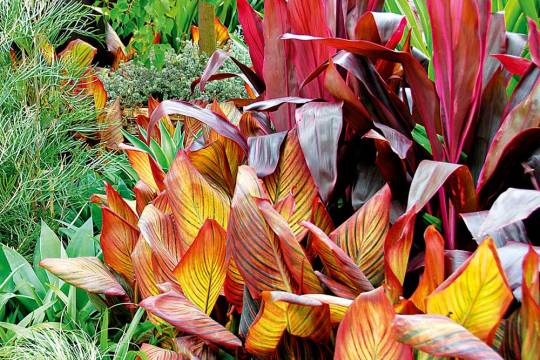
Colourful canna lilies and cordylines make great accent plants in the middle layer
Low growers
When it comes to the lower layer, dense planting adds to the rich feeling of a tropical-style garden.
TOP PICKS Bromeliad, bird’s nest fern, Philodendron ‘Xanadu’, cycad, clivia, lily turf, acalypha, aglaonema, caladium, coleus, croton, maranta, calathea and impatiens.

Croton is an eye-catching choice for the low layer

Enhance the look by attaching bromeliads, Spanish moss, epiphytic orchids and staghorn or elkhorn ferns to trees
Add a pond
Water is an important part of the tropical look, so add a pond. And if you include a fountain, you’ll also benefit from the soothing sound of running water.
But if space is limited, plant a water bowl. The plants need to be positioned at the correct height in the water. Lotus plants and waterlilies should go deep in the water while others do best with the rim of the pot just above water level.
You can gain the correct height for the pots by standing them on bricks or an empty upturned pot in the base of the water container.

If a pond isn’t an option, create an imitation stream bed with pebbles and rocks, softening the edges with overhanging plants
Did you know?
Stone and terracotta plant pots add to the tropical ambience, especially when they have aged. You can speed up the ageing process by painting them with a solution of diluted yoghurt.
Plant up the pots with colourful dwarf bougainvillea, New Guinea impatiens or tropical rhododendrons (Vireya Group)
[external_link offset=2]

Lay terracotta urns among plants and add statues to complete the look
Pave the way
When it comes to creating a tropical feel, any pathways you build should have a natural appearance.
Stone pavers combined with gravel or interplanted with miniature mondo grass, or railway sleepers used with pebbles or bark mulch look great.
A slightly raised path made from timber decking boards always works well in this kind of lush setting.
If you already have unappealing concrete floors or pathways in the backyard, you can also lay boards on top to conceal them from view.
Furniture to fit
Cane, timber, stone and concrete furniture all suit a tropical-themed garden, so team cane Asian-style furniture with lots of cushions.
Add a day bed to provide a place where you can relax and enjoy your luscious new garden.
Timber benches, chairs and tables can be left unpainted if you want a simple look or brightly coloured for a more exotic appearance.
If you have any unsightly walls or fences you want to conceal, bamboo screens are ideal for this purpose.
Planting in cool climes
You can still create a tropical-style garden in a cool frost-free or temperate area. The plants you select may not be tropical in origin, but as long as they have the look, they’ll work.
Upper canopy Suitable palms for this layer include Bangalow palm (Archontophoenix cunninghamiana), European fan palm (Chamaerops humilis) and Chinese windmill palm (Trachycarpus fortunei).
Lilly pilly, Magnolia ‘St Mary’, Michelia albaand clumping bamboo are good for screening, while tall tree ferns and Abyssinian banana (Ensete ventricosum) provide height and shade.
Middle layer Use flax, cordyline, Beschorneria yuccoides, yucca, Aucuba japonica ‘Variegata’, strelitzia, cane begonia, Fatsia japonica, ginger lily (Hedychium) and ornamental grasses.
Low growers Go for plectranthus, cast iron plant, impatiens, ferns, lamium, helleborus, arum lily, clivia, day lily, bromeliad and hosta.
GROW TIP Choose plants with large, colourful leaves that shout a tropical hello and they’ll fit into the scheme.

Bangalow palm

Fatsia japonica
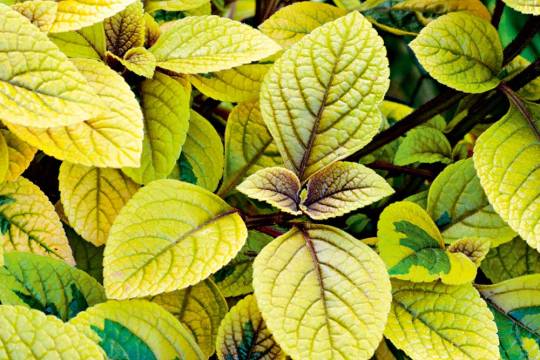
Plectranthus [external_footer]
source https://livingcorner.com.au/how-to-plan-a-tropical-garden-australian-handyman-magazinehow-to-plant-a-tropical-gardenhttps-www-handyman-net-au-wp-content-uploads-2019-11-o-landscaping-design-a-tropical-garden-jul15p1/
0 notes
Text
0 notes
Text
Ensete ventricosum, the tree against hunger
Have you heard about it? Sebuah tumbuhan jenis rerumputan, yang tingginya lebih dari 2 meter? Tumbuhan yang seringkali disebut sebagai pohon, padahal sebenarnya dia adalah tumbuhan herbal. Pisang, tidak asing, kan?
Di sini pisang bukan tokoh utamanya. Memang masih dalam satu famili, tapi kita akan membahas tumbuhan di genus yang berbeda. Pohon mirip pisang, sefamili dengan pisang dari genus musa, dan terkenal (meski tidak terkenal) dengan nama pisang etiopia. Namanya Ensete

Ensete, the false banana.
Pisang banget ga sih bentuknya? Pertama kali aku tau soal Ensete, searching, liat gambarnya, reaksiku gini ; What? Ini pisang, cuk? Ekspresi ketidakpercayaan, dengan muka you’re not gonna fooling anyone here.
But, this is not your banana. This is Ensete.
Ensete tidak berbuah seperti pisang. Di dekat jantungnya, yang di pisang kita liat ada buah, di Ensete lebih mirip buah pohon pinus yang diperbesar. Isinya biji semua, yang menjijikkan kalau diliat sama orang yang pobia titik-titik weird.
Interesting, and awesome at the same point. Liat pohon ginian, bikin aku ngerasa pengetahuanku sangat-sangat cetek.
Kadang kita ngerasa kalau semakin lama, hidup semakin membosankan. Rasanya kita udah tau soal semua hal yang kita pengen tau. Hal-hal pemacu adrenalin bakal hilang lama-lama, masuk lagi ke kotak kebosanan.
But, no. Setiap hari semesta bakal kasih kejutan dari sisi yang ngga keduga. Salah satunya ya Ensete ini. Pohon yang aku yakin, kamu ngga pernah tau kalau ada. Kemungkinannya gede, tapi kalau kamu tau, ya-maap.
Let’s talk about Ensete. In points.
Ensete itu makanan pokok buat 15-20 juta orang di Etiopia. Oke, tapi bukan disitu poin pentingnya. Bagian yang edible dari ensete ini, itu akarnya.
Poin ini mindblowing banget buatku. What? Pisang dimakan akarnya? But, it’s the truth!

Kayak talas... Eh tau talas ga? Oke, taro. Dasar milenial.
Kalau masih ga paham, talas / taro, itu buah dari tumbuhan yang sering dipake buat perasa minuman / makanan. Biasanya warna ungu, saingannya matcha.
Jadi.. Kayak talas, Ensete ini yang dimakan itu bagian corm-nya. Bagian batang yang masuk ke tanah, dan gada padanan katanya di Bahasa Indonesia. Ya akar.
If we want to talk about : menyamakan padi dengan gandum, maka Ensete disamakannya dengan talas. Udah liat foto di atas? Ibu-ibu yang lagi numbuk akar Ensete biar bisa dimakan. Fyi, disitu ada 2 akar ensete, 1 lagi ditumbuk, 1-nya lagi belum ditumbuk, tapi udah digali, persis didepannya itu lho.
Keliatan lezat banget ga sih? Tumbuhan umbi-umbian segede itu? Iyalah, 40 kilogram satu pohon. Direbus rasanya kayak mukbang. Biasanya lahan seluas 250 meter persegi udah cukup buat menghidupi keluarga dengan 5-6 anggota.
Akar ensete abis di tumbuk itu mirip tepung. Starchy gitu. Starch / amilum / pati, identik sama tepung dan tumbuhan karbohidrat. Meski pati lebih identik lagi sama rumah cewekku, sih.. Eh.
Ensete ini, kalau masih fresh, bisa dimasak langsung kayak kentang. Meski lebih terkenal kalau dijadiin Kocho. Makanan khas Etiopia terbuat dari fermentasi tumbukan Ensete. Ensete ditumbuk, difermentasi, diambil, dibikin adonan, di-bake pakai peralatan tradisional, jadilah Kocho, makanan pesta Etiopia.
Slow clap.
Keren ya, Ensete. Lucu, ada tumbuhan kayak gitu.
Sekarang tugasku sudah selesai. Menulisakan garis besar super abstrak, dan ga jelas. Info-info lain agak lumayan susah dicari, jadi kutaruh aja beberapa link menarik yang aku ngga sengaja nemu.
Ini video Ensete dari awal panen sampai jadi Kocho. Komennya bahasa Etiopia semua guys.
youtube
Ini garis besar dari salah satu website organisasi paling informatif soal pisang : http://www.promusa.org/blogpost357-Enset-the-false-banana
Gitu aja sih. Bingung mau nulis apa lagi. Tapi, kalau ada rekomendasi hal-hal unik weird kayak gini, boleh dong aku dikasih tau. Butuh banyak asupan ilmu biar semakin tau kalau kita terlalu kecil buat dunia yang luas.
Terakhir (banget). Stay, humble.
0 notes